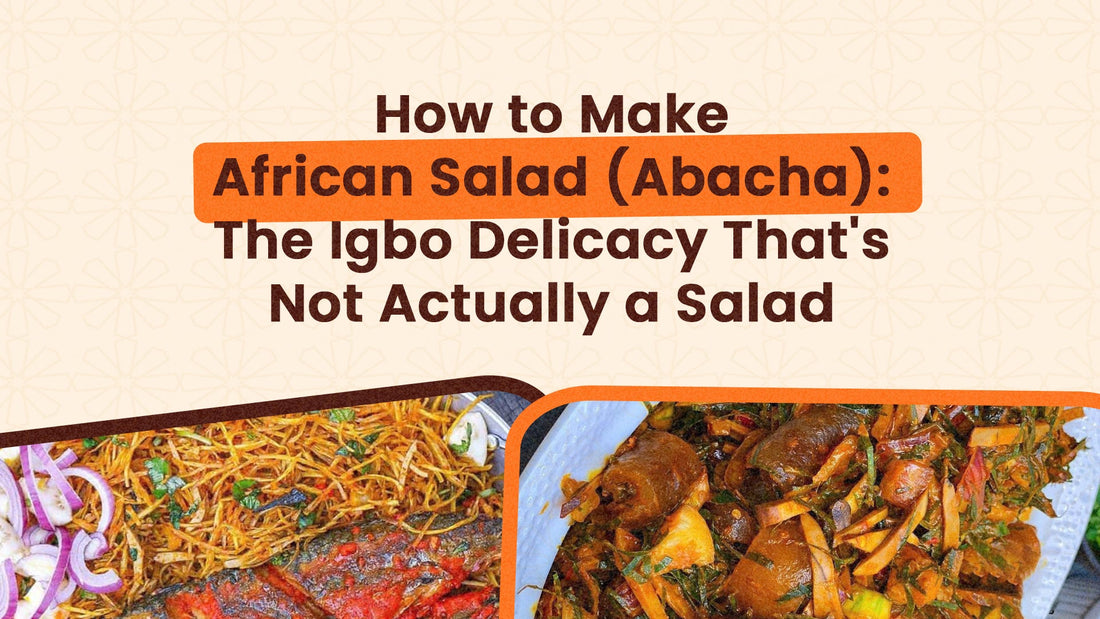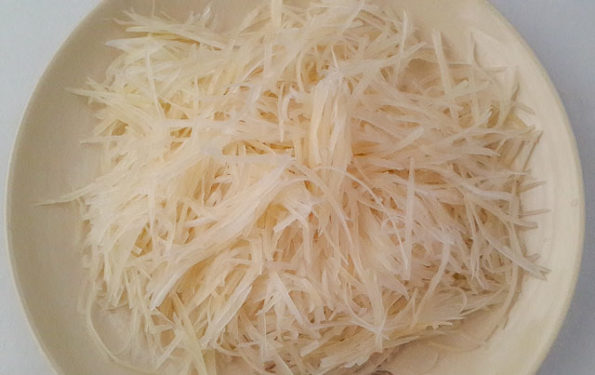
How to Make African Salad (Abacha): The Igbo Delicacy That's Not Actually a Salad
Share
If you've ever been to an Igbo gathering and seen people gathered around a large bowl of something that looks nothing like Caesar salad, you've witnessed the African salad experience. Despite its name, Abacha—or African salad—isn't leafy greens with dressing. It's shredded dried cassava mixed with palm oil, fermented oil beans, fish, and spices that create something unique.

Image from: Sisi Jemimah
This is the dish served to honor guests in Eastern Nigeria. The meal prepared in large earthenware bowls at naming ceremonies, weddings, and festivals. The street food that Igbo people crave when they're far from home. It's colorful, complex, slightly spicy, and completely addictive once you understand what you're tasting.
Let's learn how to make it properly.
What is Abacha, Really?
Abacha is dried, shredded cassava that's been through a lengthy traditional process. Fresh cassava tubers are boiled, peeled, sliced with a special grater into thin strips, soaked overnight, and sun-dried. The result is a cream-colored, noodle-like product that rehydrates when soaked in water.
The "salad" part comes from how it's served—cold or at room temperature, mixed with various ingredients like a composed salad. But the flavor profile is nothing like Western salads. It's earthy from palm oil, savory from crayfish and fish, slightly bitter from utazi leaves, and aromatic from traditional spices.
Ugba (also called ukpaka)—fermented oil bean seeds—is the essential companion ingredient. Without ugba, you have cassava salad, but not authentic abacha.
Essential Ingredients for Abacha

Image from: All Nigerian Recipes
Core Ingredients:
6-8 cups dried abacha - The foundation, available at African markets
2 cups ugba (ukpaka) - Fermented oil bean seeds, essential for authenticity
1/2 cup palm oil - Red, unrefined palm oil for color and flavor
1 teaspoon edible potash (akanwu) - Mixed with water to create the characteristic yellow palm oil paste
1/2 cup ground crayfish - For that deep umami flavor
2-3 scotch bonnet peppers - Ground or crushed, adjust to heat preference
3-4 ehu seeds (African nutmeg) - Roasted, peeled, and ground for aromatic depth
2 seasoning cubes - Maggi or Knorr
Salt to taste
Proteins and Garnishes:
Stockfish - Soaked and shredded
Dry fish - Deboned and flaked
Fresh mackerel - Fried
Ponmo (cow skin) - Cooked and diced
Garden eggs - Whole, for serving
Utazi leaves or garden egg leaves - Chopped, for that slight bitterness
1 large onion - Diced
Ogiri or iru (optional) - Fermented locust beans for extra depth
The beauty of Abacha is flexibility. Use what you have access to. More ingredients mean more complexity, but even a simple version tastes good.
Step-by-Step: Making Abacha
Preparation Phase (20 minutes)
Step 1: Soak the Abacha

Image from: The Pretend Chef
Place the dried abacha in a large bowl. Pour cold water over it and let it soak for 10-15 minutes until it softens and turns slightly translucent. The dried cassava will rehydrate and become pliable, almost noodle-like in texture.
Step 2: Prepare the Proteins
While the abacha soaks, prepare your proteins. Soak stockfish in warm water until soft, then shred into small pieces. Debone the dry fish and flake it. If using fresh mackerel, season and fry it until crispy. Cut cooked ponmo into small dice. Set everything aside.
Step 3: Rinse the Ugba

Image from: Wikipedia
Rinse the ugba (fermented oil beans) with lukewarm water to remove excess fermentation liquid. Drain well. Some people skip this step if they like the stronger fermented flavor, but rinsing makes it milder.
Step 4: Prepare the Potash
Image from: Pharmanews
Dissolve the edible potash in about 3-4 tablespoons of water. Stir well and strain through a fine sieve to remove any particles. Set the clear liquid aside. This is what transforms the palm oil into a thick yellow paste.
Step 5: Drain the Abacha
Once softened, drain the abacha thoroughly in a colander. You want it soft but not waterlogged. The texture should be tender but still have a slight bite.
Making the Palm Oil Base (The Secret)
This is where Abacha transforms from ingredients to an actual dish. The palm oil base is what binds everything together and provides that characteristic flavor.
Step 6: Create the Palm Oil Paste
Pour the palm oil into a large mixing bowl or pot. Add the strained potash water (start with 2 tablespoons, add more if needed). Stir vigorously with a wooden spoon or spatula.

You'll see magic happen—the red palm oil turns bright yellow-orange and thickens into a paste. This is the akanwu reacting with the oil. The consistency should be thick but spreadable, like softened butter. If it's too thick, add a tiny bit more potash water. If too thin, add more palm oil.
Building the Flavor (The Art)
Step 7: Add Aromatics and Spices
To the palm oil paste, add:
- Ground ehu seeds (African nutmeg)
- Ground crayfish
- Ground or crushed scotch bonnet pepper
- Crumbled seasoning cubes
- Salt to taste
- Ogiri or iru if using
Stir everything thoroughly into the yellow paste. Taste and adjust seasoning. Remember, this paste will coat all the abacha, so it should be well-seasoned but not overwhelming.
Step 8: Add the Ugba
Fold the rinsed ugba into the spiced palm oil mixture. The fermented beans add texture and that distinctive, funky-savory note that makes abacha special. Mix well so the ugba is evenly distributed.
Step 9: Combine with Abacha
Add the drained abacha to the bowl with your palm oil-ugba mixture. Using your hands or a large spoon, mix everything together thoroughly. You want every strand of cassava coated with the yellow palm oil paste.
This takes time and patience. Keep mixing, folding, and turning until the abacha is evenly yellow and well-combined with all the ingredients. The texture should be slightly glossy from the oil but not greasy or dripping.
Step 10: Add Proteins and Garnishes
Fold in your prepared proteins—shredded stockfish, flaked dry fish, diced ponmo. Add half the diced onions. Mix gently to distribute.
Add the chopped utazi leaves or garden egg leaves. Be cautious with utazi—it's quite bitter. A little goes a long way. Mix one final time.
Step 11: Garnish and Serve
Transfer to a serving platter. Garnish with:
- Whole garden eggs
- Remaining diced onions or onion rings
- Fried mackerel pieces on top
- Extra ugba on the side (some people like preparing a small portion separately with extra palm oil and pepper)
- Fresh utazi leaves
Abacha is traditionally served at room temperature or slightly chilled, never hot.
What Makes Great Abacha
The Palm Oil Matters
Quality palm oil is non-negotiable. Refined or old palm oil creates bland, unappealing abacha. You need deep red, fragrant, unrefined palm oil that actually tastes like palm oil.
Potash Ratio is Key
Too much potash makes the oil taste soapy and bitter. Too little means the oil won't emulsify properly. Add gradually and stop when you achieve that thick yellow paste.
Don't Rush the Mixing
Each ingredient gets added and mixed separately for a reason. This ensures even distribution and prevents clumping. When you rush and dump everything together, you get uneven seasoning.
Balance the Bitterness
Utazi leaves provide characteristic slight bitterness, but too much overwhelms the dish. Start with less than you think you need.
Texture Contrast
Good abacha has multiple textures—soft cassava strands, chewy ugba, crunchy garden eggs, flaky fish. This contrast makes every bite interesting.
Regional Variations and Personal Touches
Every Igbo family makes abacha slightly differently. Some add more fish, others more vegetables. Some like it spicy, others mild. Some add boiled eggs, others add fresh vegetables like cucumber.
Minimalist Abacha: Just abacha, ugba, palm oil, crayfish, and pepper. Simple but delicious.
Deluxe Abacha: Multiple fish types, ponmo, garden eggs, utazi, garden egg leaves, extra onions. The full experience.
Vegetarian Abacha: Skip all animal proteins, load up on vegetables, and ugba. Still satisfying.
Protein-Heavy Abacha: Add shrimp, boiled eggs, more fish. Makes it a complete meal.
Serving and Pairing
Abacha is typically eaten as an in-between meal or snack, though it can be substantial enough for a full meal depending on how much protein you add.
Traditional pairing: Chilled palm wine. The slightly sweet, fizzy palm wine cuts through the richness of the palm oil perfectly.
Modern pairings: Cold zobo (hibiscus drink), fresh fruit juice, or cold beer.
When to serve: Afternoon gatherings, as part of a party spread, naming ceremonies, or whenever you're craving something different from soup and rice.
Serve it in a large communal bowl with individual plates, or plate individually for each guest. Provide garden eggs on the side for people to eat between bites.
Storage and Make-Ahead Tips
Abacha is best eaten fresh. The texture and flavors are optimal within a few hours of making it. However, you can refrigerate leftovers for up to 24 hours. The cassava will absorb more oil, and the texture will change slightly, but it's still edible.
Before refrigerating, cover tightly to prevent it from drying out. When ready to eat, let it come to room temperature and stir well. You might need to add a bit more palm oil to refresh it.
You can prep components ahead:
- Soak and cook proteins the day before
- Prepare and rinse ugba in advance
- Make the potash mixture ahead
But don't mix everything until shortly before serving. Once combined, abacha doesn't improve with time.
Common Mistakes to Avoid
Mistake 1: Using refined palm oil
Creates pale, flavorless abacha. You need authentic red palm oil from L'Afrique Market.
Mistake 2: Over-soaking the abacha
Makes it too soft and mushy. 10-15 minutes is enough.
Mistake 3: Adding too much potash
Ruins the taste. Add gradually, stir, check consistency.
Mistake 4: Skipping the ugba
Without fermented oil beans, it's just cassava salad, not abacha.
Mistake 5: Not mixing thoroughly
Results in some bites being over-seasoned, others bland.
The Cultural Significance
Abacha isn't just food—it's hospitality. In Igbo culture, serving abacha to guests shows respect and welcome. It's labor-intensive to prepare properly, which makes offering it meaningful.
At village gatherings, women prepare it communally, chatting and adjusting seasoning together until everyone agrees it's perfect. It's social, collaborative cooking at its finest.
During festivals and celebrations, large bowls of abacha appear alongside other dishes. At naming ceremonies, it's almost mandatory. At weddings, guests judge the host partly by the quality of the abacha served.
For Igbo people in the diaspora, abacha represents home. It's the dish they crave when homesick, the flavor that transports them back to village gatherings and family celebrations.
Where to Find Ingredients
Making authentic abacha outside Nigeria requires sourcing specific ingredients. L'Afrique Market stocks the essentials you can't find at regular grocery stores:
- Authentic red palm oil with proper flavor and color
- Ground crayfish for that distinctive umami
- Stockfish properly dried and preserved
- Dried abacha cassava strips
- Ugba (fermented oil beans)
- Edible potash
- Traditional spices
Without these authentic ingredients, you're approximating rather than making real abacha.
Final Thoughts
Abacha takes time and specific ingredients, but it's not technically difficult. The key is having quality components and understanding the technique of creating that palm oil paste.
Start with a simple version—just abacha, ugba, palm oil, crayfish, and pepper. Master that, then add more ingredients as you become comfortable with the process.
The first time might not be perfect. The potash ratio might be off, or the seasoning might need adjustment. That's fine. Abacha is forgiving enough that even imperfect versions taste good.
With practice, you'll develop your own style. Maybe you prefer it spicier. Maybe you love extra fish. Maybe you skip the ponmo but add extra garden eggs. Make it yours while respecting the fundamentals.
And when you finally get it right—when the palm oil paste is perfect, the seasoning balanced, the texture just right—you'll understand why Igbo people love this dish so much. It's not just cassava and palm oil. It's culture, community, and connection in a bowl.
